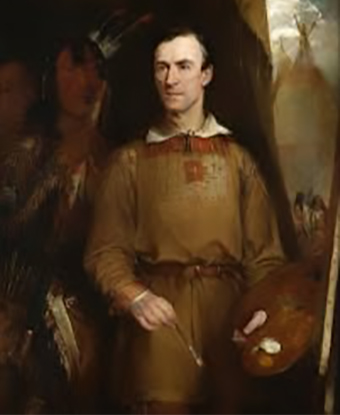Last updated: August 31, 2020
Person
George Catlin

Public Domain
George Catlin was born in Pennsylvania in 1796. As a child, Catlin was interested in Indians, natural history, science, and the arts. He was educated at home and trained as a lawyer, giving up that profession when a group of Native Americans visited Philadelphia. The group sparked his interest and he decided to devote his career to painting Indians in their native land. As a painter, Catlin was largely if not entirely self-taught.
Catlin spent 1830 to 1836 traveling thousands of miles from the Missouri to the Southwest, which resulted in his producing 470 portraits and portrayals of Indian life representing almost forty different tribes. In 1832, Catlin had his most productive year for painting Indians in the field. He traveled up the Missouri aboard the American Fur Company's new steamboat Yellowstone on its first voyage to Fort Union Trading Post in North Dakota, almost 2,000 miles above Saint Louis. On this trip, he painted the Assiniboin, Blackfoot, Crow, Plains Ojibwa, and Cree. Further downriver he visited and painted the Hidatsa and Mandan, semi-sedentary farming tribes in their palisaded villages of earth lodges near Fort Clark.
It was during his travels among many different Indian Tribes in the early 1830's that Catlin noticed many Chiefs and warriors using pipes made of a richly colored, red stone. When he asked about the stone, he was told of a single quarry near the dividing ridge between the Mississippi and Missouri rivers. Indians claimed the site was sacred ground where Indians of many tribes met in peace to quarry the stone which was the color of human blood. Catlin became very interested in finding the source of this remarkable stone, and set off in search of the fabled pipestone quarry.
In 1836, despite objections from the Santee Sioux, Catlin insisted on visiting the pipestone quarries (what today is known as Pipestone National Monument). The Santee told Catlin that the area was off limits to whites, but Catlin later admitted that his curiosity and determination increased with their vehemence. After visiting the quarries, he took a sample of pipestone away with him and sent it to Boston to be analyzed. It was named Catlinite by the geologist who received the sample of this stone, which was previously unrecorded in modern science.
The number of whites who visited during the 1830s increased, with shorter and shorter time between visits. By the end of the decade, the steady stream of white visitors had begun to bring the quarry to the attention of the non-Native world.
